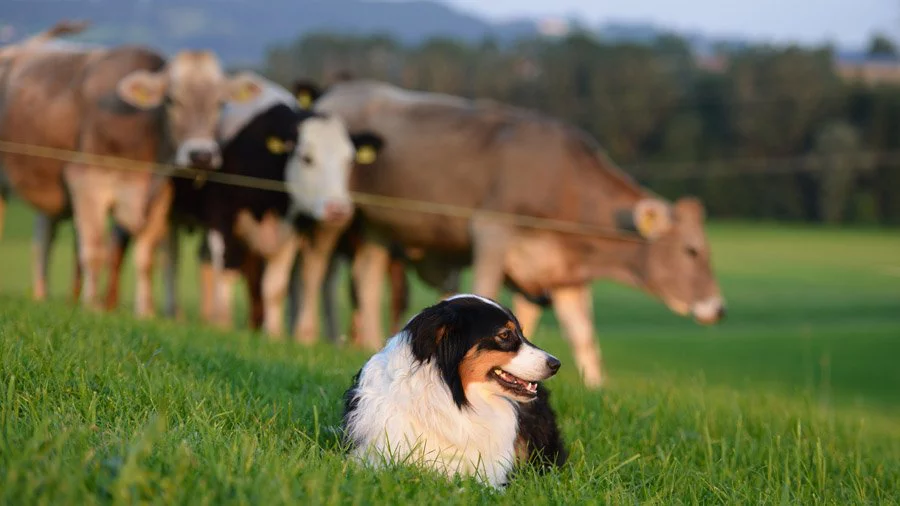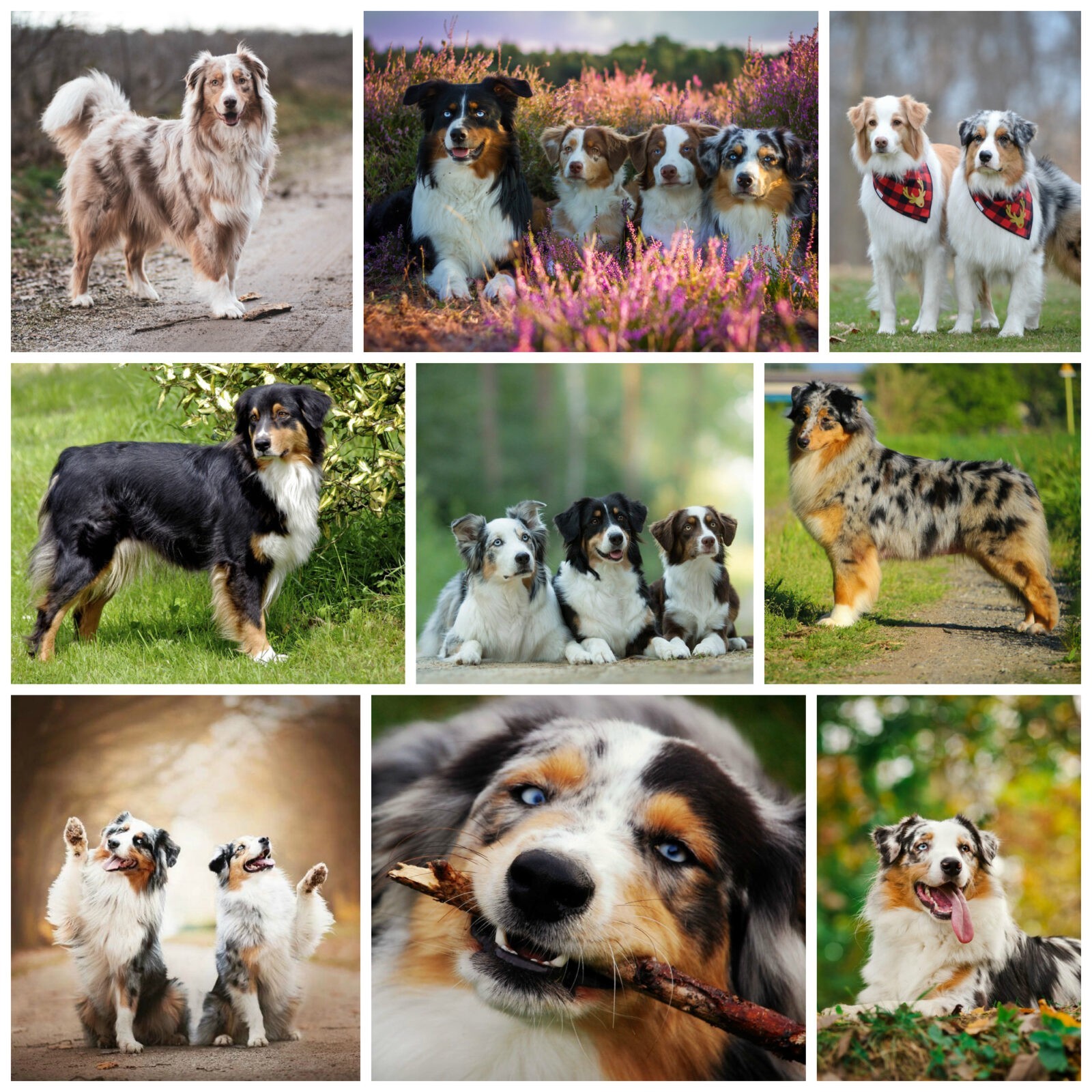
Краткое описание породы австралийская овчарка
Несмотря на название породы, родина австралийских овчарок (которых также называют аусси или оусси) — Соединенные Штаты Америки. Первоначальным предназначением этих средних по размеру собак (около 46-60 см в высоту, вес от 22 до 30 кг) была помощь фермерам в выпасе и перегоне скота. Также эти четвероногие всегда славились как собаки-компаньоны из-за своего спокойного и жизнерадостного нрава. Превосходны они и на службе в государственных органах (в том числе в поиске наркотиков, спасении людей), почитаемы в качестве поводырей. Сегодня племенные питомники аусси есть во всем мире, в том числе и в России. Особенно подходят австралийские овчарки активным людям, готовым уделить должное внимание долгим и интересным прогулкам питомца и регулярному уходу за шикарной густой шерстью.
Основная информация
| Название породы: | Австралийская овчарка |
| Страна происхождения: | США |
| Время зарождения породы: | XIX век |
| Тип: | пастушьи и скотогонные |
| Вес: | 22 – 30 кг |
| Рост (высота в холке): | 46 – 60 см |
| Продолжительность жизни: | 12 – 14 лет |
|
Классификация МКФ:
|
Группа 1, Секция 1, Номер 342 |
| Цена щенков: | 50 – 570 $ |
| Самые популярные клички: | список кличек для австралийской овчарки |
Оценка характеристик породы австралийская овчарка
| Адаптивность
(определение, означающее, насколько легко собака может приспосабливаться к изменениям в жизни) |
🐶🐶🐶🐶🐶 |
| Уровень линьки
(Уровень и частота выпадения волос у животного) |
🐶🐶🐶 |
| Уровень нежности
(Уровень и количество нежности и ласки, которую собака отдает взамен на внимание к себе) |
🐶🐶🐶🐶 |
| Потребности в упражнениях
(Уровень дневной активности собаки) |
🐶🐶🐶🐶🐶 |
| Социальная потребность
(Необходимое количество контактов собаки с другими животными, а также людьми) |
🐶🐶🐶🐶 |
| Квартирное содержание
(Фактор, определяющий уровень шума и иных неудобств, которые собака может доставлять хозяевам в соотношении размера квартиры к размеру собаки) |
🐶🐶🐶 |
| Груминг
(Количество купаний, расчесываний, а также необходимое количество сеансов профессионального груминга, необходимого собаке) |
🐶🐶🐶 |
| Дружелюбность в незнакомой среде
(Особенности поведения собаки в обществе с незнакомыми людьми или в незнакомой обстановке) |
🐶🐶 |
| Тенденция к лаю
(Склонность к лаю и его частоте и громкости) |
🐶🐶🐶🐶🐶 |
| Вопросы здоровья
(Потенциальный уровень состояния здоровья собаки) |
🐶🐶🐶 |
| Территориальность
(Склонность собаки к защите своего дома, двора или даже автомобиля хозяина) |
🐶🐶🐶🐶🐶 |
| Дружелюбность к котам
(Тенденция к терпимости к кошкам и пониженное проявление охотничьих инстинктов) |
🐶🐶🐶 |
| Интеллект
(Способность собаки к мышлению и решению возникающих трудностей (не стоит путать с обучаемостью!) |
🐶🐶🐶🐶🐶 |
| Воспитание и дрессировка
(Уровень сложности в обучении собаки выполнять определенные действия) |
🐶🐶🐶🐶🐶 |
| Дружелюбность к детям
(Фактор, определяющий насколько собака дружелюбна к детям, любит ли она с ними играть и терпеть некоторые детские шалости) |
🐶🐶🐶🐶🐶 |
| Игровая активность
(Понятие определяется самим его названием, и, как правило, встречается почти у всех собак) |
🐶🐶🐶🐶🐶 |
| Наблюдательность
(Способность собаки определить присутствие чужого на своей территории) |
🐶🐶🐶🐶🐶 |
| Дружелюбность к другим собакам
(Склонность собаки находить общий язык с другими своими сородичами) |
🐶🐶🐶 |
Внешний вид австралийской овчарки
Австралийские овчарки — собаки в меру мускулистые, с хорошо развитым костяком. Голова их пропорциональна телу, сухая, возможен выступ в области затылка. Переход к морде ото лба хорошо выражен. Глаза аусси живые, умные, миндалевидной формы, среднего размера, светло- или темно-коричневого, а также голубого оттенка. Нередко наблюдается гетерохромия (когда один глаз темного цвета, а другой светлого). Нос среднего размера, черный или коричневый (при коричневом носе допустимы небольшие розовые отметины впигментации) в зависимости от окраса собаки. Уши среднего размера, высокого постава, преломлены на хряще и устремлены вперед, не должны быть стоячими или висячими. Челюсти крепкие, образующие прямой или ножницеобразный прикус. Шея крепкая, средняя по длине. Грудь глубокая, с овальными ребрами. Корпус крепкий, в меру мускулистый и сильный. Спина аусси ровная и крепкая, расширяющаяся в районе поясницы. Круп несколько скошен, живот в области паха подобран. Конечности австралийских овчарок костистые, прямые и сильные, лапы овальные, хорошо сжатые. Хвост аусси может быть от рождения как в меру длинным, так и коротким, словно купированным. Шерстный покров густой, волнистый или прямой, хорошо развит подшерсток. В области головы и передней части конечностей шерсть относительно короткая, тогда как на шее, задней части передних конечностей, на задних конечностях шерсть заметно длиннее, присутствуют очесы. Признанные окрасы аусси — черный, красный, блю (голубой) — мерль (черные пятна на сером фоне), ред (красный) — мерль (красные пятна на пегом или бежевом фоне). Белый и пегий оттенки шерсти возможны на груди, конечностях и животе собаки. Непризнанными окрасами считаются золотистый, графитовый, соболиный, тигровый.
Австралийская овчарка фото:

История происхождения породы австралийская овчарка
Появление предков австралийских овчарок на территории США в 19 веке часто приписывается исключительно пастухам-баскам и их пиренейским пастушьим собакам. Однако не все так просто в этой запутанной американо-австралийско-немецко-испанской истории. По мнению некоторых исследователей породы, предками австралийских овчарок являются и другие овчарки — старонемецкие (точнее, одна из их разновидностей — тигры (тайгеры) — пастушьи собаки с густой шерстью мраморного серо-черного окраса, чьей родиной считается Германия). Старонемецкие овчарки попали на территорию Нового Южного Уэльса в Австралии в середине 19 столетия для охраны и выпаса отар овец. И только потом, как было сказано выше, потомки тайгеров (старонемецких собак), скрещенные с собаками других пород, попали в США.
Еще одними предками аусси считают породу под названием пиренейская овчарка. Эти собаки из Андорры (небольшой страны между Францией и Испанией) попали в США во второй половине 19 века. Вместе с басками пиренейские овчарки прибыли для помощи американской овечьей промышленности, набиравшей обороты в США в то время. Третьей породой, повлиявшей на возникновение австралийских овчарок, называют австралийских кули — прекрасных аборигенных пастушьих собак, справляющихся со стадами овец, коз и коров. По окрасу и характеристикам кули напоминают современных аусси (к слову, как и старонемецкие и пиренейские овчарки).
Фермерам Соединенных штатов настолько понравились качества этих выносливых и трудолюбивых пород, что начиная с первых десятилетий 20 века, велась селекционная работа по выведению новой породы путем скрещивания кули, пиренейских и старонемецких овчарок с другими породами (бернским зенненхундом и представителями группы пастушьих собак колли). Так и появилась австралийская овчарка. Уже с 1957 года стал функционировать Американский Клуб австралийских овчарок, к 1970-м появилось более 25 питомников, а в 1977 году был утвержден Стандарт породы.
Характер австралийской овчарки
Правильно воспитанные аусси являются веселыми, активными и жизнерадостными собаками, с любовью относящимися не только к хозяину, но и ко всем членам семьи, включая детей. К посторонним четвероногие любимцы такой породы относятся с настороженностью, хотя обычно без агрессии или страха. К домашним питомцам аусси спокойны, особенно к тем, которых знают с щенячьего возраста (владелец должен научить щенка австралийской овчарки правильно реагировать на кошек и собак сызмала). Аусси очень преданы хозяину, обожают находиться в его обществе. Владельцы такой породы отмечают острый ум, любопытство, прекрасное послушание аусси. Они крайне редко бывают злобными к людям или животным, прекрасно поддаются дрессировке.
Владельцу необходимо обеспечить животное достаточными физическими нагрузками. Австралийские овчарки очень активные рабочие собаки, поэтому просиживание в стенах квартиры чревато не только депрессией, но и шалостями, когда собака сама находит себе занятие в виде порчи имущества хозяина. Поэтому и заводить их стоит легким на подъем людям, располагающим достаточным количеством времени для общения и прогулок с собакой.
Содержание и уход
Австралийские овчарки могут прекрасно проживать как на территории участков частных или загородных домов, так и в квартирах. Уличное содержание предполагает возведение вольера с утепленной на зимний период будкой. На цепи аусси держать не рекомендуется. В квартирах же требуется отвести собаке уголок с лежанкой, мисками и игрушками, нужно следить за отсутствием сквозняков и чрезмерно иссушенного воздуха.
Прогулки с такими собаками производятся дважды (или более) в день по 1-1,5 часа. В жару время выгула можно сократить или же вывести животное в максимально прохладные часы летом (утром и вечером), когда солнце не так палит. Холод, как правило, аусси переносят неплохо. Собака должна бегать, выполнять команды владельца. С интересом и успехом аусси участвуют в ловле пластиковых дисков (фрисби), мяча (флайбол), преодолении полосы препятствий (аджилити). Во время загородных поездок аусси с удовольствием носятся по местности, летом обожают купаться (после плавания нужно внимательно осмотреть тело собаки, а вернувшись домой, сполоснуть шерсть проточной водой). После прогулки также необходимо мыть и осматривать лапы собаки на наличие ранок.
Уход за австралийскими овчарками включает в себя процедуры по вычесыванию и мытью собаки. Во время линьки (весной и осенью, а при проживании в квартире периоды могут быть затянуты) аусси вычесывают ежедневно при помощи гребня и щетки или фурминатора. В обычное время старая собачья шерсть удаляется путем вычесывания 2-3 раза в неделю. Очень важно не пренебрегать этими процедурами, поскольку густая шерсть и внушительный подшерсток аусси могут подтолкнуть к возникновению кожных заболеваний, появлению паразитов, образованию колтунов. Купают этих овчарок около 4 раз в год при помощи специального зоошампуня для собак.
Непременные условия содержания – протирка глаз несколько раз в неделю ватным тампоном, смоченным в чайной заварке или отваре ромашки. Уши любимца протирают 1 либо 2 раза в неделю ватным диском, смоченным в воде или специальном средстве для удаления серы. Зубы аусси непременно должны быть в порядке, поэтому хозяину стоит приобрести специальные средства для собак – зубную пасту и щетку, а также лакомства для удаления зубного налета.
Любой признак болезни (температура свыше 39 градусов или ниже 37 градусов, расстройства ЖКТ, выделения из глаз, ушей, носа, апатия и другие тревожные звоночки) является немедленным поводом для обращения к ветеринару. У врача (желательно перед покупкой собаки) необходимо узнать, какие именно лекарства должны быть в домашней аптечке на случай оказания первой помощи на дому самим хозяином. И именно у ветеринара следует проконсультироваться о витаминах, вакцинах и противопаразитарных средствах (частоте приема, дозах, способах введения). Заниматься самолечением не следует, поскольку это опасно для жизни собаки.
Дрессировка и обучение
Здоровье и болезни
Несколько интересных фактов
- Голубоглазых австралийских овчарок с легкой руки индейцев, также почитавших этих четвероногих трудяг, называют призрачноглазыми (или собаками-приведениями).
- На территории России аусси появились лишь во второй половине 1990-х.
- Цена на щенка австралийской овчарки начинается от 20000-25000 рублей и выше.
Питомники и заводчики
Материал мы заимствовали с замечательного сайта наших партнеров DOGCATFAN.COM о кошках и собаках, автор dogcatfan
